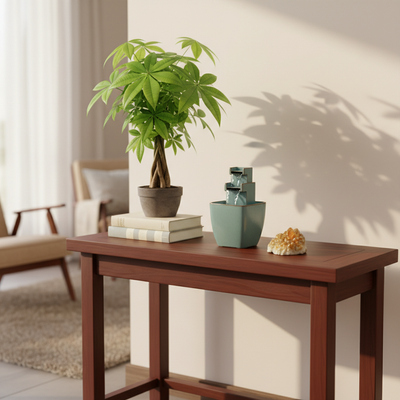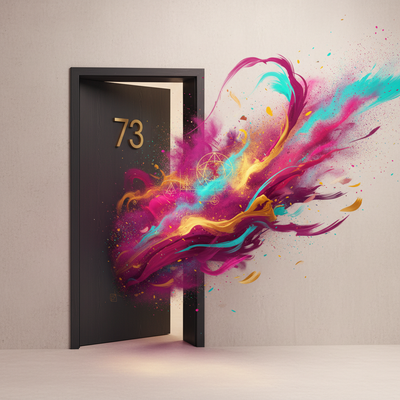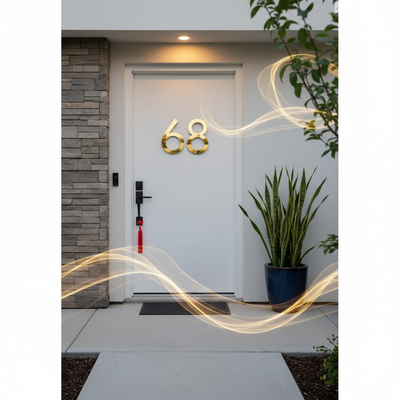Why Your Bedroom's Energy Is Important

Do you toss and turn at night? Do you feel tired even after sleeping for eight hours? Your bedroom might be causing the problem. We often think stress or busy lives are to blame, but the place where we spend one-third of our lives has a big impact on how we feel. This is what Chinese bedroom feng shui teaches us.
This old practice is not just about making rooms look nice. It is the skill of arranging your space to help positive life energy flow better. This energy is called Qi. A bedroom with good Qi becomes a true safe place—somewhere that helps you sleep deeply, keeps you healthy, and makes your relationships stronger.
This guide gives you clear, step-by-step ways to change your bedroom. We will focus on the useful wisdom of Feng Shui and give you tools to create a space that helps you feel better every single night.
Learning the Basic Rules
Before we move anything in your room, you need to understand two important ideas that control all bedroom Feng Shui: how Qi flows and the Commanding Position. When you understand the "why" behind these rules, you can make smart changes that last.
What is Qi?
Think of Qi as invisible life energy that moves through everything in the world. It flows through our bodies and our homes. In a living space, you can think of it like a gentle, slow-moving stream. When this stream gets blocked or stops moving, it creates feelings of heaviness and tiredness. If it moves too fast—like in a straight line from a door to a window—it can feel disturbing and unsettling.
In the bedroom, the goal is to create Qi that is calm, helpful, and moves slowly. This type of energy lets your own personal Qi settle and get stronger while you sleep, which leads to deep rest and healing.
The Commanding Position
The most important rule in Chinese bedroom feng shui is putting your bed in the Commanding Position. This rule comes from our basic need to feel safe. To be in command, you must be able to see the door to your room from your bed without being directly in line with it.
This placement puts you in control of your life and your space. You can see what is coming, so your mind can fully relax. Being directly lined up with the door, often called the "coffin position," puts you in the path of the strongest, fastest-moving Qi, which makes it hard to sleep and creates feelings of danger.
Here's how to check your bed placement:
- Best Placement: The bed sits diagonally across from the door. You have a clear view of the entrance while lying down.
- Good Placement: The bed is on the same wall as the door but far enough away that you can easily see the entrance without turning your head completely. A mirror can be placed to see the door if a direct view is not possible, but this is a backup solution.
- Bad Placement: The bed is directly in line with the door, with your feet pointing toward it.
- Bad Placement: The bed's headboard is against the same wall as the door, so you cannot see who enters without sitting up and turning around.
Getting the Commanding Position right is the first and most powerful step you can take to improve your bedroom's energy.
Main Feng Shui Elements
Now that you understand the basic principles, we can apply them to the specific parts of your room. This step-by-step guide will help you arrange your space for the best harmony and rest.
Bed and Headboard
Your bed is the most important piece of furniture in the room. Where you put it and how it is built matter most.
- Do: Choose a bed with a solid, strong headboard. The headboard gives you a sense of support and stability behind you while you sleep.
- Do: Place the headboard firmly against a solid wall. This makes the feeling of security and support in your life stronger.
- Don't: Place your bed under a window. Qi can come in and go out through the window, creating a flow of energy over your head that disturbs sleep. It also lacks symbolic support.
- Don't: Put your bed under a sloped ceiling or an exposed overhead beam. These building features create heavy energy that can make you feel weighed down and cause headaches and pressure.
The Power of Color
Colors represent the Five Elements in Feng Shui: Wood, Fire, Earth, Metal, and Water. For a bedroom, the goal is peace.
- Good Colors: We suggest using colors connected to the Earth and Metal elements. These include soft, neutral colors like beige, cream, terracotta, and gentle pastels. These "skin-tone" colors are naturally calming and grounding, helping create feelings of stability.
- Use Carefully: Fire element colors (red, bright orange, deep purple) and Water element colors (dark blue, black) are very activating. While a small touch of red can help with passion, too much can lead to restlessness or arguments. Deep blues and black can feel heavy and add to feelings of sadness if used too much. Use these as small accents only.
The Mirror Mistake
One of the most well-known Feng Shui rules is to avoid having a mirror that reflects the bed. This is not superstition; it has a real energetic reason.
A mirror doubles and bounces energy. When it reflects you and your partner sleeping, it can symbolically "invite" a third person into the relationship, creating problems. On a more practical level, the active energy a mirror creates can disturb the calm Qi needed for sleep. Waking up in the middle of the night to see a moving reflection can also be shocking to your nervous system.
- Solution: The best place for a full-length mirror is on the inside of a closet door. Or, place it on a wall that does not face the bed.
Cleaning Up for Clarity
In Feng Shui, clutter is more than just a mess; it is a physical sign of stuck energy. A cluttered room blocks the gentle flow of Qi, leading to feelings of being stuck, overwhelmed, and tired.
The most important area to fix is the space under your bed. This area is closely connected to your subconscious mind while you sleep. Storing items here, especially those with emotional weight like old letters, work files, or shoes from a past relationship, means you are literally "sleeping on" those problems all night. This can show up as unsettled sleep and an inability to move forward in life. The space under your bed should be completely empty and clean.
Lighting, Artwork, and Electronics
These elements set the final layer of atmosphere in your sanctuary.
- Lighting: Avoid harsh, direct overhead lighting. Instead, choose layered lighting with multiple, softer sources like bedside lamps or a floor lamp with a dimmer switch. This lets you control the mood and create a gentle, Yin environment as you wind down.
- Artwork: The art in your bedroom should reflect what you want to grow in your life. Choose images that are peaceful, happy, and hopeful. For those seeking or building a relationship, images that show pairs are excellent. Avoid artwork that is lonely, sad, chaotic, or aggressive.
- Electronics: The bedroom should be a tech-free zone. Televisions, computers, and even phones give off electromagnetic fields (EMFs) and blue light that interfere with sleep patterns. They also represent the active, "Yang" energy of work and communication, which is the opposite of the restful "Yin" energy a bedroom requires. Create a charging station outside the room.
| Quick Reference Guide: Bedroom Feng Shui |
| :--- | :--- |
| Category | Do's |
| Bed Placement | Place in the Commanding Position. Use a solid headboard against a solid wall. |
| Colors | Use soft, neutral, earthy tones (beige, cream, pastels). |
| Mirrors | Place inside a closet or on a wall that does not reflect the bed. |
| Clutter | Keep the entire room, especially under the bed, clear and organized. |
| Decor | Choose serene, positive artwork. Use soft, layered lighting. |

| Electronics | Remove all TVs, computers, and exercise equipment from the bedroom. |
A Real-Life Change
Theory is helpful, but seeing the principles work provides true understanding. At THE QI FLOW, we often see how simple space changes can lead to big life improvements. This case is a perfect example.
The Client's Problem
A couple came to us, describing a shared sense of exhaustion. The wife had chronic insomnia, often waking at 3 a.m. with a racing mind. The husband felt a growing distance in their relationship. They described their bedroom as a "stale" and functional space they went to out of necessity, not desire. It was a room for sleeping, but it wasn't a room for resting.
Our Team's Analysis
When the THE QI FLOW team did an on-site consultation, we found several major energy blocks.
First, the bed was in a vulnerable position. The headboard was under a large window, and their feet pointed directly toward the bedroom door. This created a constant, subconscious feeling of insecurity and placed them in a direct "rush" of Qi.
Second, a large, fancy mirror on the wall opposite the bed reflected the couple as they slept, energetically amplifying every toss and turn and symbolically disrupting their union.
Finally, the space under their bed was packed with old university textbooks and files from a previous stressful job. This stuck energy, tied to past pressures and identities, was connecting them to a state of unresolved stress every night.
The Feng Shui Solution
Our recommendations were practical and focused on immediate impact. We didn't suggest a costly renovation, but rather a strategic rearrangement.
- Reposition the Bed: We moved the bed to the adjacent wall, placing it in the Commanding Position, diagonally opposite the door with a solid wall behind it.
- Relocate the Mirror: The beautiful mirror was moved to the entryway hall, where it could welcome energy into the home instead of disrupting sleep.
- Clear the Subconscious: The clients cleared everything from under the bed, donating the books and shredding the old files in a cathartic release.
- Soften the Ambiance: We suggested new bedding in a soft, earthy taupe color to ground the energy and introduced a pair of matching bedside lamps to foster relational balance.
The Amazing Results
The effects were quick and significant. Within two weeks, the wife reported sleeping soundly through the night for the first time in over a year. The couple shared that the simple act of entering the room now felt calming. They described their bedroom as their "haven" and "recharge station," and spoke of a renewed sense of closeness and intimacy. This case powerfully shows how Chinese bedroom feng shui is a direct and effective tool for enhancing well-being.
Advanced Feng Shui Tips
Once you have the basics in place, you can improve your bedroom's energy with these more advanced techniques.
The Principle of Pairs
To grow partnership energy, everything in the bedroom should be balanced in pairs. This creates a visual and energetic representation of a harmonious union.
- Two Nightstands: One on each side of the bed. Having only one can subconsciously create an imbalance in the relationship.
- Two Lamps: Matching lamps on the nightstands provide balanced light and energy.
- Symmetry: Whenever possible, create a sense of symmetry around the bed. This doesn't mean everything must be identical, but it should feel balanced.
This principle is helpful even for single people looking to attract a partner, as it creates the energetic space for someone to enter their life.
Plants in the Bedroom
This is a topic of much debate. In traditional Feng Shui, live plants are generally discouraged in the bedroom. Plants represent active, growing "Yang" energy and release carbon dioxide at night. This can be too stimulating for a space dedicated to restful "Yin" energy.
However, we believe in a modern, balanced approach. If you love plants and they bring you joy, you don't have to remove them entirely.
- Our Recommendation: If you choose to have plants, limit them to one or two small ones.
- Choose Wisely: Pick plants with soft, rounded leaves over those with sharp, "spiky" points.
- Placement is Key: Place them far from the bed, such as on a dresser or in a corner, so their active energy doesn't interfere directly with your sleep.
The Bedroom Bagua Map
The Bagua is the Feng Shui energy map, an octagon divided into nine areas, or "guas," each corresponding to a different aspect of life. You can overlay this map on your bedroom layout to diagnose and enhance specific life areas.
To do this, stand at the doorway of your bedroom looking in. Mentally place a three-by-three grid over the room.
- The far right corner from the door is the Kun area, representing Love and Relationships. To enhance this, place items in pairs, a photo of you and your partner, or artwork depicting romance. Pink and red are excellent accent colors here.
- The near left corner from the door is the Gen area, for Knowledge and Self-Cultivation. This is a perfect spot for books you are reading, a meditation cushion, or an image that inspires personal growth.
Focusing on just these two areas within the bedroom can have a powerful effect on your relationships and personal development.
Your Action Checklist
Use this checklist to assess your room and begin your transformation. Don't feel you have to do everything at once. Start with the change that feels easiest.
Your Bedroom Feng Shui Reset Checklist
-
The Foundation:
- [ ] Is my bed in the Commanding Position (view of the door, not in line with it)?
- [ ] Do I have a solid headboard?
- [ ] Is my headboard placed against a solid wall?
-
Energy Flow:
- [ ] Is the space under my bed completely clear?
- [ ] Is my bedroom free of general clutter?
- [ ] Is there a clear path to walk on both sides of the bed?
-
Objects & Decor:
- [ ] Is there a mirror reflecting the bed? (If yes, move it!)
- [ ] Does my artwork evoke positive, calm, or romantic feelings?
- [ ] Are my nightstands and lamps balanced in a pair?
- [ ] Are there any dead or dying plants in the room?
-
Atmosphere:
- [ ] Are the dominant colors in my room soft and restful (neutrals, earth tones)?
- [ ] Are electronics (TV, computer, phone) kept away from my bed at night?
- [ ] Is the lighting soft and layered rather than harsh and overhead?
Conclusion: Your Journey Begins
Chinese bedroom feng shui is a powerful and accessible tool for creating a personal sanctuary. It's about making conscious, intentional choices in your environment that support your health, nurture your relationships, and bring you peace of mind. Your bedroom should be the one place in the world where you can completely let go and recharge.
You don't need a massive budget or a complete overhaul to start. Begin with one small change from the checklist. Move your bed. Clear the clutter from one corner. Notice how the room feels. Your journey to a more restful and harmonious life is a series of simple, intentional steps, and it begins now.








0 comments